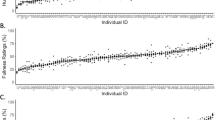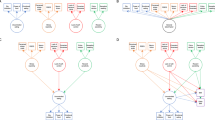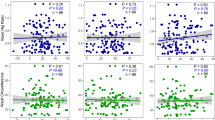Abstract
Objective:
It has been shown repeatedly that impulsivity, obesity and food intake are related; obese people are more impulsive than lean people and impulsive people eat more than less impulsive people. The relation between impulsivity and food intake might be state dependent; hunger motivates food seeking behaviour and food consumption, especially of high caloric food. Difficulties to overrule automatic behavioural tendencies might make impulsive people more susceptible to the effects of hunger on food selection. Therefore, they are expected to increase their intake more than low impulsive people when feeling hungry.
Study 1:
Fifty-seven female participants were randomly assigned to a hunger or sated condition. Response inhibition (a measure of impulsivity) and food intake were measured. Results show that impulsive participants ate significantly more, but only when feeling hungry.
Study 2:
Ninety-four undergraduate students participated. Hunger, response inhibition and the purchase of food in a virtual supermarket were measured. The same interaction was found: impulsive participants bought most calories, especially from snack food, but only when feeling hungry.
Conclusion:
Hunger and impulsivity interact in their influence on consumption. These data suggest that reducing hunger during calorie restricting diets is important for successful weight loss, particularly for the impulsive dieters.
This is a preview of subscription content, access via your institution
Access options
Subscribe to this journal
Receive 12 print issues and online access
$259.00 per year
only $21.58 per issue
Buy this article
- Purchase on Springer Link
- Instant access to full article PDF
Prices may be subject to local taxes which are calculated during checkout


Similar content being viewed by others
References
Schrauwen P, Westerterp KR . The role of high-fat diets and physical activity in the regulation of body weight. Br J Nutr 2000; 84: 417–427.
Seidell J . Dietary fat and obesity: an epidemiologic perspective. Am J Clin Nutr 1998; 67: 546S–550S.
Skinner JD, Bounds W, Carruth BR, Morris M, Ziegler P . Predictors of children's body mass index: a longitudinal study of diet and growth in children aged 2–8 years. Int J Obes 2004; 28: 476–482.
Cutting TM, Fisher JO, Grimm-Thomas K, Birch LL . Like mother, like daughter: familial patterns of overweight are mediated by mothers’ dietary disinhibition. Am J Clin Nutr 1999; 69: 608–613.
Ebbeling CB, Sinclair KB, Pereira MA, Garcia-Lago E, Feldman HA, Ludwig DS . Compensation for energy intake from fast food among overweight and lean adolescents. J Am Med Ass 2004; 291: 2828–2833.
Johnson SL, Birch LL . Parents’ and children's adiposity and eating style. Pediatrics 1994; 94: 653–661.
Ravussin E, Bogardus C . Energy balance and weight regulation: genetics versus environment. Br J Nutr 2000; 83: S17–S20.
Schrauwen P, Westerterp KR . The role of high-fat diets and physical activity in the regulation of body weight. Br J Nutr 2000; 84: 417–427.
Goris AHC, Westerterp KR . Physical activity, fat intake and body fat. Physiol Behav 2008; 94: 164–168.
Davis C, Levitan RD, Smith M, Tweed S, Curtis C . Associations among overeating, overweight, and attention deficit/hyperactivity disorder: a structural equation modelling approach. Eat Behav 2006; 7: 266–274.
Guerrieri R, Nederkoorn C, Stankiewicz K, Alberts H, Geschwind N, Martijn C et al. The influence of trait and induced state impulsivity on food intake in normal-weight healthy women. Appetite 2007; 49: 66–73.
Nederkoorn C, Braet C, Van Eijs Y, Tanghe A, Jansen A . Why obese children cannot resist food: the role of impulsivity. Eat Behav 2006; 7: 315–322.
Solanto MV, Abikoff H, Sonuga-Barke E, Schachar R, Logan GD, Wigal T et al. The ecological validity of delay aversion and response inhibition as measures of impulsivity in AD/HD: a supplement to the NIMH multimodal treatment study of AD/HD. J Abnorm Child Psychol 2001; 29: 215–228.
Doughterty DM, Bjork JM, Harper RA, Marsh DM, Moeller FG, Mathias CW et al. Behavioral impulsivity paradigms: a comparison in hospitalized adolescents with disruptive behavior disorders. J Child Psychol Psych 2003; 44: 1145–1157.
Sigal JJ, Adler L . Motivational effects of hunger on time estimation and delay of gratification in obese and nonobese boys. J Gen Psychol 1976; 128: 7–16.
Franken IH, Muris P . Individual differences in reward sensitivity are related to food craving and relative body weight in healthy women. Appetite 2005; 45: 198–201.
Nederkoorn C, Smulders FTY, Havermans RC, Roefs A, Jansen A . Impulsivity in obese women. Appetite 2006; 47: 253–256.
Agranad-Meged AN, Deitcher C, Goldzweig G, Leibenson L, Stein M, Galili-Weisstub E . Childhood obesity and attention deficit/hyperactivity disorder: a newly described comorbidity in obese hospitalized children. Int J Eat Dis 2005; 37: 357–359.
Holtkamp K, Konrad K, Müller B, Heussen N, Herpertz S, Herpertz-Dahlmann B et al. Overweight and obesity in children with attention deficit/hyperactivity disorder. Int J Obes 2004; 28: 685–689.
Guerrieri R, Nederkoorn C, Jansen A . How impulsiveness and variety influence food intake in a sample of healthy women. Appetite 2007; 48: 119–122.
Guerrieri R, Nederkoorn C, Jansen A . The interaction between impulsivity and a varied food environment: its influence on food intake and overweight. Int J Obes 2008; 32: 708–714.
Jansen A, Nederkoorn C, van Baak L, Keirse C, Guerrieri R, Havermans R . High-restrained eaters only overeat when they are also impulsive. Behav Res Ther 2009; 47: 105–110.
Guerrieri R, Nederkoorn C, Schrooten M, Jansen A . Inducing impulsivity leads high and low restrained eaters into overeating, whereas current dieters stick to their diet. Appetite (in press).
Rotenberg KJ, Lancaster C, Marsden J, Pryce S, Williams J, Lattimore P . Effects of priming thoughts about control on anxiety and food intake as moderated by dietary restraint. Appetite 2005; 44: 235–241.
Raynor HA, Epstein LH . The relative-reinforcing value of food under differing levels of food deprivation and restriction. Appetite 2003; 40: 15–24.
Stafford LD, Scheffler G . Hunger inhibits negative associations to food but not auditory biases in attention. Appetite 2008; 51: 731–734.
Tuorila H, Kramer FM, Engell D . The choice of fat-free vs regular-fat fudge: the effects of liking for the alternative and the restraint status. Appetite 2001; 37: 27–32.
Siep N, Roefs A, Roebroeck A, Havermans R, Bonte ML, Jansen A . Hunger is the best spice: an fMRI study of the effects of attention, hunger, calorie content on food reward processing in the amygdala and orbitofrontal cortex. Behav Brain Res 2009; 198: 149–158.
Logan GD, Schachar RJ, Tannock R . Impulsivity and inhibitory control. Psychol Sci 1997; 8: 60–64.
Stunkard AJ, Messick S . The three-factor eating questionnaire to measure dietary restraint, disinhibition and hunger. J Psychosom Res 1985; 29: 71–83.
Herman CP, Polivy J . Restrained eating. In: Stunkard AB (ed). Obesity. Saunders: Philadelphia, 1985, pp 208–255.
Jeffrey R, Epstein LH, Wilson GT, Drewnowski A, Stunkard AJ, Wing RR et al. Long-term maintenance of weight loss: current status. Health Psychol 2000; 19 (Suppl. 1): 5–16.
Wadden TA, Sternberg JA, Letizia KA, Stunkard AJ, Foster GD . Treatment of obesity by very low calorie diet, behavior therapy, and their combination: a five-year perspective. Int J Obes 1989; 13 (Suppl. 2): 39–46.
Nederkoorn C, Jansen E, Mulkens S, Jansen A . Impulsivity predicts treatment outcome in obese children. Behav Res Ther 2007; 45: 1071–1075.
Rubio MA, Gargallo M, Isabel-Millan I, Moreno B . Drugs in the treatment of obesity: sibutramine, orlistat and rimonabant. Pub Health Nutr 2007; 10: 1200–1205.
Francis LA, Ventura AK, Marini M, Birch LL . Parent overweight predicts daughters’ increase in BMI and disinhibited overeating from 5 to 13 years. Obesity 2007; 15: 1544–1553.
Fisher JO, Birch LL . Eating in the absence of hunger and overweight in girls from 5 to 7 years of age. Am J Clin Nutr 2002; 76: 226–231.
Shunk JA, Birch LL . Validity of dietary restraint among 5- to 9-year old girls. Appetite 2004; 42: 241–247.
Logan GD, Cowan WB . On the ability to inhibit thought and action: a theory of an act of control. Psychol Review 1984; 91: 295–327.
Mattes RD . Physiological responses to sensory stimulation by food: nutritional implications. J Am Diet Ass 1997; 97: 406–410.
Nederkoorn C, Smulders FTY, Jansen A . Cephalic phase responses, craving and food intake in normal subjects. Appetite 2000; 35: 45–55.
Band GPH, van Boxtel GJM . Inhibitory motor control in stop paradigms: review and reinterpretation of neural mechanisms. Acta Psychologica 1999; 101: 179–211.
Acknowledgements
We would like to thank Jacco Ronner for technical assistance with the development of the virtual supermarket.
Author information
Authors and Affiliations
Corresponding author
Rights and permissions
About this article
Cite this article
Nederkoorn, C., Guerrieri, R., Havermans, R. et al. The interactive effect of hunger and impulsivity on food intake and purchase in a virtual supermarket. Int J Obes 33, 905–912 (2009). https://doi.org/10.1038/ijo.2009.98
Received:
Revised:
Accepted:
Published:
Issue Date:
DOI: https://doi.org/10.1038/ijo.2009.98
Keywords
This article is cited by
-
Does hunger promote the detection of foods? The effect of value on inattentional blindness
Psychological Research (2022)
-
Changes over time in the relationship between weight, body fat, motivation, impulsivity and eating behaviour
BMC Public Health (2021)
-
Implicit bias to food and body cues in eating disorders: a systematic review
Eating and Weight Disorders - Studies on Anorexia, Bulimia and Obesity (2021)
-
Associations between inhibitory control, eating behaviours and adiposity in 6-year-old children
International Journal of Obesity (2019)
-
Towards the measurement of food literacy with respect to healthy eating: the development and validation of the self perceived food literacy scale among an adult sample in the Netherlands
International Journal of Behavioral Nutrition and Physical Activity (2018)



